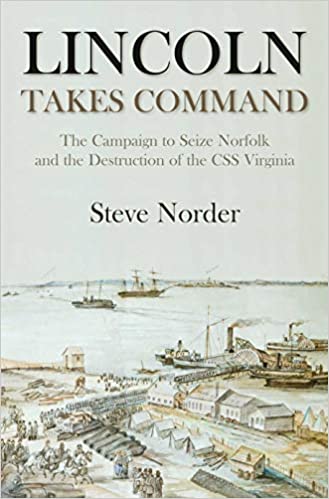
Reviewed by John Grady.
If it’s a clear day and you stand on Fort Monroe’s ramparts, you can see the edge of the “carrier piers” at the Norfolk Naval Station. There, a few miles away across Hampton Roads, are usually two of the nation’s largest warships — either ready for deployment or just returned.
If you were with Abraham Lincoln and his entourage as they looked across those waters in spring 1862, you, like they, could say “how can this be?” Why do those rebels still hold “that place,” meaning all of southside Hampton Roads? It had confounded his party for months before they gathered with maps and charts in a yacht-turned revenue cutter’s salon to steam to the “seat of war.”
As Steve Norder points out in Lincoln Takes Command, just out of sight from the embankments of the moated fort, around a curl of land, Sewell’s Point, lays the Union Navy’s nemesis, the iron-plated, ram-tipped, slow, deep-drafted CSS Virginia. Louis Goldsborough, the senior Union naval officer present, is using his “little” Monitor to move out only when necessary to hold in check the slope-sided ironclad. The losses and damages of March that his command suffered demanded caution.
With Lincoln’s slow-acting bane in Army blue uniform, George Brinton McClellan inching slowly up the Virginia Peninsula, the president saw himself as the commander-in-chief of forces on the ground and the water, not a tourist in Hampton Roads. Norder reminds us the one-time Illinois militia captain in the early 1830s and back bench Whig congressman opposed to the War with Mexico in the 1840s had “never led a military operation,” until that moment.
It was a step that George Washington hadn’t taken in the Whiskey Rebellion and one Jamie Madison sidestepped at Bladensburg in the fiasco that allowed the White House to be torched.
Steve Norder has given us a fascinating look at Lincoln, who was still grieving over the loss of his son Willie, and dozens of other players, both major like the ancient Army veteran John Wool and almost as ancient Navy veteran Josiah Tattnall, as well as minor, like busy note-taker Thomas Jefferson Cram and shipboard engineer Elsberry White in Lincoln Takes Command.
This day-by-day account of the re-taking the port of Norfolk and its cross-river sister shipyard town Portsmouth from the Confederacy is fascinating. And oh yes, the destruction of the “deadly looming presence,” CSS Virginia, aka USS Merrimack, is exceptionally well-told in this little-known story.
As Norder recounts in an appendix, Cram’s writings are invaluable. A reader needs to know Cram is a man well into his 50s and an accomplished engineer.
The Union Army and Navy often worked at cross purposes with each other, a fact this book captures well. They also worked under the overbearing eye of Edwin Stanton. Norder’s detailing of who is to command, where to land an invasion force, how it is to be supported from shore to beach, how they are to be reinforced, what route to take, resistance, et al., is superb.
He captures Wool’s predicament — having a president, cabinet officers — add Treasury’s Salmon P. Chase to the mix, and their horse-holders from Washington — perfectly. The veteran of the War of 1812 didn’t expect any major resistance and didn’t find much. But his too-long in garrison troops, apparently not used to the march, withered on the miles-long trek from Ocean View to the port. Their trail of discarded gear was disgraceful.
If confusion and fatigue marked the Union moves, stovepiped-service silence and the ensuing bedlam it caused summed up the Confederate side. Loose lips certainly can sink ships, but … The Confederate Army commanders closed mouths about their orders to grab everything that could be moved, put it on trains, and “get the hell out of Dodge” with your men to defend Richmond is classic in its folly.
Although Jefferson Davis’ order to evacuate was correct, the Army’s execution needs to be taught in every staff and war college as “stay-in-your-own lane” stupidity that left the Navy adrift and civil authorities confounded. The commander of its largest warship had two choices: suicidal attack on the Union fleet or try to escape up the shoaly James.
Tattnall, Virginia’s skipper, knew several lighter draught, faster vessels had made it, but the captain, try as he and the crew hoped, knew the effort was doomed to failure. The ship was simply too heavy. The final explosion of Virginia off Craney Island was a Valhalla of the gods. White remembered flames “issuing from the port holes, through the grating and smokestack.” The engineer called it a “more beautiful sight I never beheld than that great ship on fire.”
Lincoln Takes Command is a superb addition in understanding the dramatic shifting of the war’s shape and scale in the year after the Confederate bombardment of Fort Sumter.
As Norder explains, that year so tested Lincoln that his answer was: take command.
Steve Norder, Lincoln Takes Command, The Campaign to Seize Norfolk and the Destruction of the CSS Virginia, (El Dorado Hills, Calif.: Savas Beatie, 2020), 209 pp., maps, photos and illustrations, appendices, index, bibliography
Reviewed by John Grady, author of Matthew Fontaine Maury: Father of Oceanography. Grady also has contributed to Sea History, Naval History, the New York Times “Disunion” series, Civil War Monitor, and was a blogger for the Navy’s Sesquicentennial of the Civil War.
Purchase your copy of Lincoln Takes Command today! amzn.to/39ENUFS


Sarah Keeney